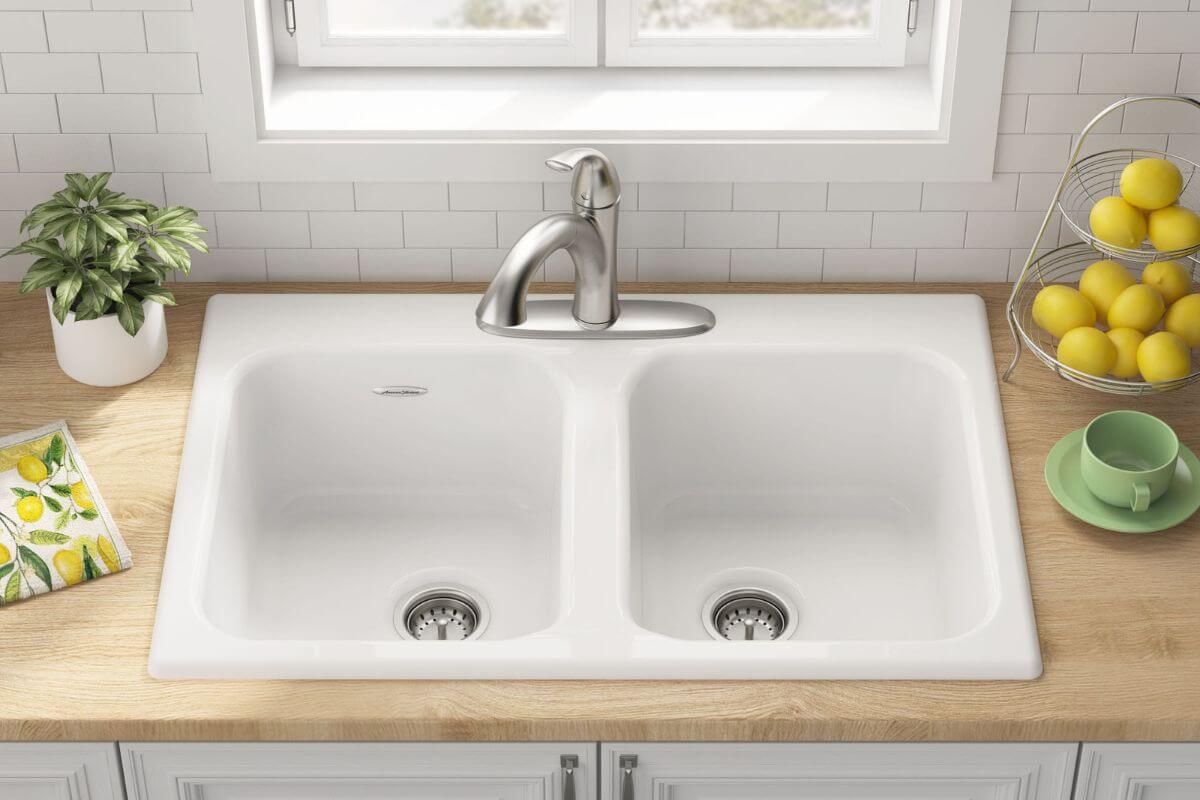Introduction
When it comes to choosing the perfect sink for your kitchen, you’ll likely encounter various options. Two popular choices are cast iron sinks and stainless steel sinks. Both have their unique features and benefits, making the decision-making process a bit perplexing. In this article, we’ll compare and contrast cast iron sinks and stainless steel sinks to help you make an informed choice for your kitchen.
The Basics of Cast Iron Sinks
Cast iron sinks have been a staple in traditional kitchens for decades. They are made from molten iron that is poured into a mold to form the sink’s shape. The sink is then coated with enamel, giving it a glossy and durable finish. The enameling process allows for a wide range of color options, making it easy to find a cast iron sink that complements your kitchen decor.
Advantages of Cast Iron Sinks
- Durability: Cast iron sinks are exceptionally sturdy and can withstand heavy daily use without chipping or scratching easily.
- Heat Resistance: They can handle high temperatures, making them ideal for placing hot pots and pans without damage.
- Aesthetic Appeal: The glossy enamel finish gives cast iron sinks a timeless, elegant look.
Drawbacks of Cast Iron Sinks
- Weight: Cast iron sinks are considerably heavier than stainless steel sinks, making installation more challenging.
- Prone to Chipping: While durable, the enamel coating can chip if heavy objects are dropped into the sink.
Getting to Know Stainless Steel Sinks
Stainless steel sinks are a modern favorite for many homeowners. They are made from a combination of steel and chromium, which provides excellent resistance to corrosion and staining. The sleek, minimalist appearance of stainless steel sinks makes them a popular choice for contemporary kitchen designs.

Advantages of Stainless Steel Sinks
- Low Maintenance: Stainless steel sinks are easy to clean and maintain, as they do not require special care or cleaning products.
- Affordability: Compared to cast iron sinks, stainless steel sinks are generally more budget-friendly.
- Lightweight: Stainless steel sinks are lighter, simplifying the installation process.
Drawbacks of Stainless Steel Sinks
- Prone to Scratches: While durable, stainless steel sinks are more susceptible to scratching, which may affect their appearance over time.
- Noise and Vibration: They can be noisier when water hits the surface, but adding sound-dampening pads can help minimize this.
Durability and Longevity
Cast Iron Sink Durability
Cast iron sinks are known for their exceptional durability, capable of lasting for several decades with proper care. The enamel coating provides a protective barrier against stains and scratches, further extending their lifespan.
Stainless Steel Sink Durability
Stainless steel sinks are also durable and can withstand the rigors of daily use. While they may develop minor scratches over time, they are less prone to chipping and are highly resistant to corrosion.
Longevity Comparison
Both cast iron sinks and stainless steel sinks are built to last. The longevity of each sink depends on how well they are maintained and used.
Maintenance and Cleaning
Caring for Cast Iron Sinks
To maintain a cast iron sink’s pristine appearance, avoid using abrasive cleaners that could damage the enamel. Clean it regularly with a mild detergent and a soft cloth to prevent stains.
Caring for Stainless Steel Sinks
Stainless steel sinks require minimal effort to keep clean. Use a non-abrasive cleaner and a soft sponge to remove any stains or marks. Additionally, applying a stainless steel polish can help maintain the sink’s shine.
Cleaning Comparison
While both sink types require regular cleaning, stainless steel sinks are generally easier to clean and less prone to staining.
Design and Style Options
Cast Iron Sink Designs
Cast iron sinks come in various designs, including single and double basins, with different installation options (undermount, drop-in, or farmhouse style). The enamel finish allows for a wide range of color choices to match your kitchen decor.
Stainless Steel Sink Designs
Stainless steel sinks offer a sleek and modern appearance, available in different configurations, including single and double bowls, undermount, top mount, and farmhouse styles. While color options are limited, the neutral tone of stainless steel complements various kitchen styles.
Finding the Right Style for Your Kitchen
When choosing between the two, consider the overall design theme of your kitchen and how the sink will fit in with the existing elements.
Cost Considerations
Cast Iron Sink Prices
Cast iron sinks tend to be more expensive than stainless steel sinks due to their manufacturing process and durability.
Stainless Steel Sink Prices
Stainless steel sinks are generally more budget-friendly, making them a popular choice for those on a tighter budget.
Balancing Budget and Quality
When deciding between the two sinks, consider your budget constraints and how much you are willing to invest in a long-lasting, high-quality sink.
Sound Dampening and Heat Retention
Cast Iron Sink Properties
Cast iron sinks have natural sound-dampening properties, reducing the noise of running water and clattering dishes.
Stainless Steel Sink Properties
Stainless steel sinks can be noisier when water strikes the surface, but some sinks come with sound-dampening pads to minimize noise.
Sound and Heat Comparison
If noise reduction is a significant concern, cast iron sinks might be the preferred choice. However, if you regularly handle hot pans, stainless steel sinks offer better heat resistance.
Environmental Impact
Eco-Friendliness of Cast Iron Sinks
Cast iron sinks are more environmentally friendly due to their longer lifespan and recyclable materials.
Eco-Friendliness of Stainless Steel Sinks
Stainless steel sinks are also recyclable but may have a slightly shorter lifespan than cast iron sinks.
Making a Green Choice
Consider the environmental impact of each sink type when making your decision.
Installation Process
Installing Cast Iron Sinks
The weight of cast iron sinks requires more robust support during installation, which may require professional assistance.
Installing Stainless Steel Sinks
Stainless steel sinks are lighter and more straightforward to install, making them a suitable DIY project for some homeowners.
Complexity and Ease of Installation
The ease of installation depends on your DIY skills and whether you have access to the necessary tools and support.
Stain and Scratch Resistance
Cast Iron Sink Characteristics
The enamel coating of cast iron sinks provides excellent stain resistance, ensuring they retain their appearance over time.
Stainless Steel Sink Characteristics
While stainless steel sinks can develop minor scratches, they are less prone to staining and corrosion.
Maintaining a Spotless Sink
Both sinks offer good stain resistance, but cast iron sinks might be more forgiving when it comes to scratches.
Suitability for Different Kitchen Styles
Cast Iron Sinks in Traditional Kitchens
The classic and elegant appearance of cast iron sinks complements traditional and vintage kitchen styles.
Stainless Steel Sinks in Modern Kitchens
Stainless steel sinks are an excellent choice for contemporary and minimalist kitchen designs.
Blending Sink with Kitchen Aesthetics
Choose a sink that harmonizes with your kitchen’s overall theme and style to create a cohesive look.
Impact on Resale Value
Cast Iron Sink’s Effect on Home Value
Investing in a durable and aesthetically pleasing cast iron sink can positively impact your home’s resale value.
Stainless Steel Sink’s Effect on Home Value
Stainless steel sinks are popular among homebuyers, contributing positively to the overall resale value of your property.
Investment Perspective
Consider your long-term plans and how the sink’s value may affect your home’s potential resale value.
Choosing the Ideal Sink for Your Kitchen
When choosing between cast iron sinks and stainless steel sinks, assess your needs, lifestyle, and kitchen design preferences. Weigh the advantages and drawbacks of each sink type to make an informed decision that aligns with your budget and personal style.
Conclusion
In conclusion, both cast iron sinks and stainless steel sinks have their merits and unique characteristics. Cast iron sinks offer timeless elegance and remarkable durability, while stainless steel sinks provide a sleek, modern appearance and are more budget-friendly. Consider your kitchen’s style, your maintenance preferences, and your long-term investment goals when selecting the perfect sink for your kitchen.
FAQs
Are cast iron sinks more challenging to install than stainless steel sinks?
Yes, due to their weight, cast iron sinks may require additional support during installation, making them more complex to install than lighter stainless steel sinks.
Do stainless steel sinks scratch easily?
Stainless steel sinks are durable but may develop minor scratches over time, especially with heavy use.
Which sink type is more environmentally friendly?
Both sink types are recyclable, but cast iron sinks generally have a longer lifespan, making them more environmentally friendly.
Can I place hot pots and pans directly on a cast iron sink?
Yes, cast iron sinks are heat-resistant and can handle high temperatures.
Do stainless steel sinks make more noise than cast iron sinks?
Yes, stainless steel sinks can be noisier when water strikes the surface, but sound-dampening pads can help minimize noise levels.



